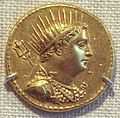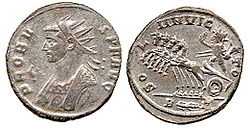Radiant crown
A radiant or radiate crown, also known as a solar crown or sun crown, is a crown, wreath, diadem, or other headgear symbolizing the sun or more generally powers associated with the sun. It typically takes the form of either a horned disc to represent the sun, or a curved band of points to represent rays.
In the iconography of ancient Egypt, the solar crown is a disc framed by the horns of a ram[1] or cow. It is worn by deities such as Horus in his solar or hawk-headed form,[2] Hathor, and Isis. It may also be worn by pharaohs.[3]
In Ptolemaic Egypt, the solar crown could also be a radiate diadem, modeled after the type worn by Alexander the Great (as identified with the sun god Helios) in art from the mid-2nd century BC onward.[4] It was perhaps influenced by contact with the Sunga Empire,[5] and a Greco-Bactrian example is depicted at the great stupa of Bharhut.[6] The first ruler of Egypt to wear this version of a solar crown was Ptolemy III Euergetes (246–222 BC)[7]
In the Roman Empire, the solar crown was worn by Roman emperors in association with the cult of Sol Invictus,[8] influenced also by radiant depictions of Alexander.[9] The solar crown worn by Constantine, the first emperor to convert to Christianity, was reinterpreted as representing the "Holy Nails".[10]

-

Egyptian aegis (from the Louvre)
-

Amen-Re, wearing a tall feather crown and sun disk (715–664 BC)
-
Coin issued by Alexander, King of Epeiros (333-330 BC)
-

Coin of Ptolemy IV Philopator, depicting his deified father Ptolemy III
-

Helios wearing the chlamys (Tripoli, 1st century AD)
-

Helios in a clipeus, detail from a Roman sarcophagus, early 3rd century AD
See also
References
| Wikimedia Commons has media related to Category:Radiant crowns. |
- ↑ Beatrice Teissier, Egyptian Iconography on Syro-Palestinian Cylinder Seals of the Middle Bronze Age, Orbis Biblicus et Orientalis Series Archaeologia 11 (University Press Fribourg Switzerland, 1996), p. 185; Kathlyn M. Cooney, "Apprenticeship and Figures Ostraca from the Ancient Egyptian Village of Deir el-Medina," in Archaeology and Apprenticeship: Body Knowledge, Identity, and Communities of Practice (University of Arizona Press, 2012), p. 149.
- ↑ Teissier, Egyptian Iconography, p. 50.
- ↑ Teissier, Egyptian Iconography, p. 122.
- ↑ Andrew Stewart, Faces of Power: Alexander's Image and Hellenistic Politics (University of California Press, 1993), p. 246.
- ↑ Stewart, Faces of Power, p. 180.
- ↑ Stewart, Faces of Power, p. 180.
- ↑ Stewart, Faces of Power, pp. 142, 246.
- ↑ Jonathan Bardill, Constantine, Divine Emperor of the Christian Golden Age (Cambridge University Press, 2012), p. 114.
- ↑ Stewart, Faces of Power, p. 246.
- ↑ Luke Lavan, "Political Talimans? Residual 'Pagan' Statues in Late Antique Public Space," in The Archaeology of Late Antique 'Paganism' (Brill, 2011), p. 459.

